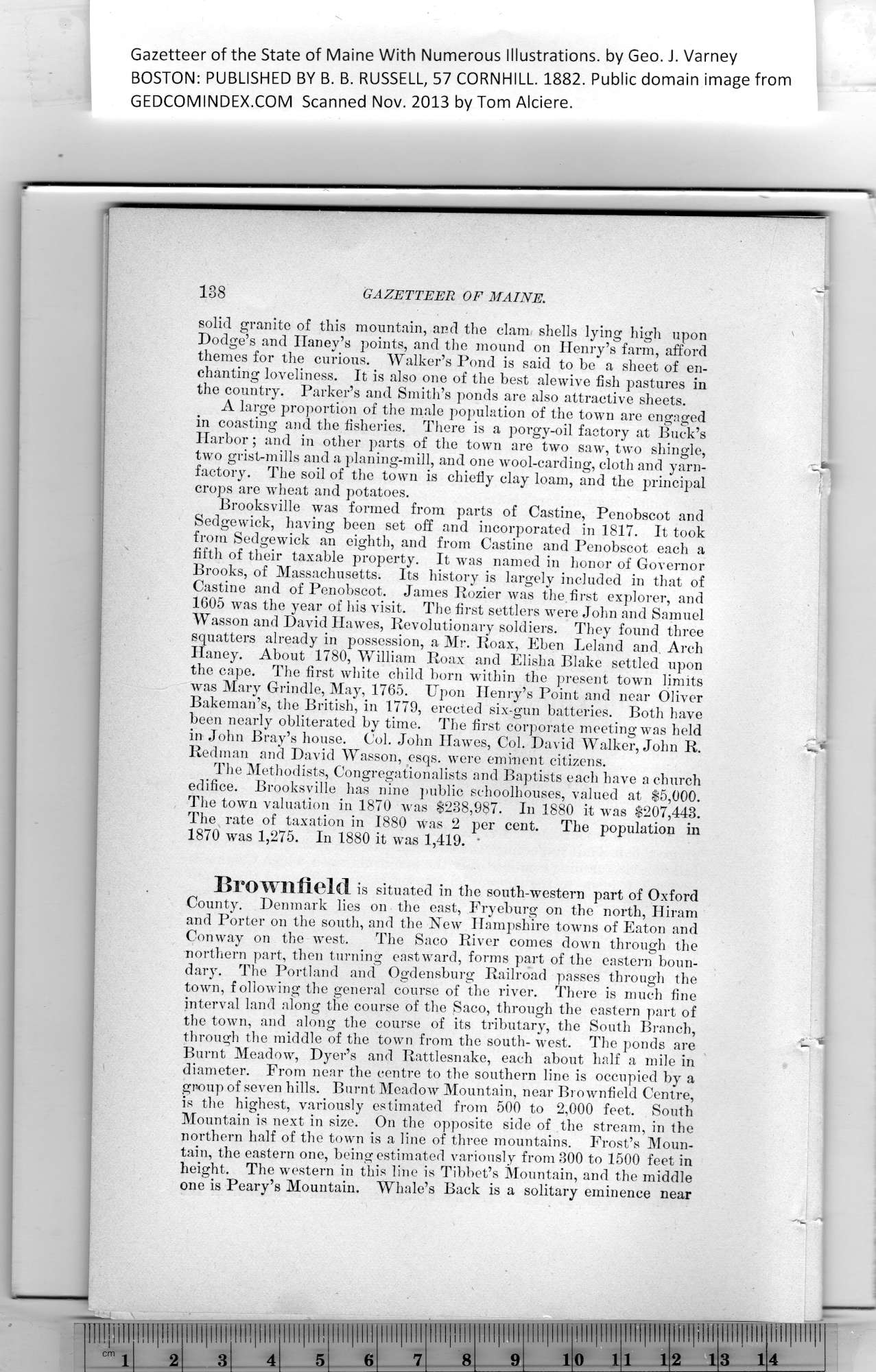|
Gazetteer of the State of Maine With Numerous Illustrations, by Geo. J. Varney
BOSTON: PUBLISHED BY B. B. RUSSELL, 57 CORNHILL. 1882. Public domain image from
138 GAZETTEER OF MAINE.
solid granite of this mountain, and the clam shells lying high upon
Dodge’s and Haney’s points, and the mound on Henry’s farm, afford
themes for the curious. Walker’s Pond is said to be’ a sheet of en-
chanting loveliness. It is also one of the best alewive fish pastures in
the country. Parker’s and Smith’s ponds are also attractive sheets.
A large proportion of the male population of the town are engaged
in coasting and the fisheries. There is a porgy-oil factory at Buck’s
Harbor; and in other parts of the town are two saw, two shingle,
two grist-mills and a planing-mill, and one wool-carding, cloth and yarn-
factory. The soil of the town is chiefly clay loam, and the principal
crops are wrheat and potatoes.
Brooksville was formed from parts of Castine, Penobscot and
Sedgewick, having been set off and incorporated in 1817. It took
from Sedgewick an eighth, and from Castine and Penobscot each a
fifth of their taxable property. It was named in honor of Governor
Brooks, of Massachusetts. Its history is largely included in that of
Castine and of Penobscot. James Rozier was the first explorer, and
1605 was the year of his visit. The first settlers were John and Samuel
Wasson and David Hawes, Revolutionary soldiers. They found three
squatters already in possession, a Mr. Roax, Eben Leland and. Arch
Haney. About 1780, William Roax and Elisha Blake settled upon
the cape. The first white child horn within the present town limits
was Mary Grindle, May, 1765. Upon Henry’s Point and near Oliver
Bakeman’s, the British, in 1779, erected six-gun batteries. Both have
been nearly obliterated by time. The first corporate meeting was held
in John Bray’s house. Col. John Hawes, Col. David Walker, John R.
Redman and David Wasson, esqs. were eminent citizens.
_ The Methodists, Congregationalists and Baptists each have a church
edifice. Brooksville has nine public schoolhonses, valued at $5,000.
The town valuation in 1870 was $238,987. In 1880 it was $207,443.
The rate of taxation in 1880 was 2 per cent. The population in
1870 was 1,275. In 1880 it was 1,419. *
Brownfield is situated in the south-western part of Oxford
County. Denmark lies on the east, Fryeburg on the north, Hiram
and Porter on the south, and the New Hampshire towns of Eaton and
Conway on the wTest. The Saco River comes down through tbe
northern part, then turning eastward, forms part of the eastern boun-
dary. The Portland and Ogdensburg Railroad passes through the
town, following the general course of the river. There is much fine
interval land along the course of the Saco, through the eastern part of
the town, and along the course of its tributary, the South Branch,
through the middle of the town from the south- west. The ponds are
Burnt Meadow, Dyer’s and Rattlesnake, each about half a mile in
diameter. From near the centre to the southern line is occupied hy a
group of seven hills. Burnt Meadow Mountain, near Brownfield Centre,
is the highest, variously estimated from 500 to 2,000 feet. South
Mountain is next in size. On the opposite side of the stream, in the
northern half of the town is a line of three mountains. Frost’s Moun-
tain, the eastern one, being estimated variously from 300 to 1500 feet in
height. The western in this line is Tibbet’s Mountain, and the middle
one is Peary’s Mountain. Whale’s Back is a solitary eminence near
PREVIOUS PAGE ... NEXT PAGE
This page was written in HTML using a program written in Python 3.2
|
